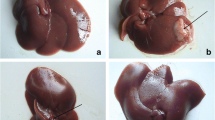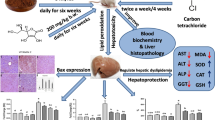Abstract
Effects of garlic (Allium sativum Linn.) on circulatory lipid peroxidation and antioxidant status were evaluated in N-Nitrosodiethylamine-induced hepatocarcinogenesis in male rats. Enhanced lipid peroxidation in the circulation of N-Nitrosodiethylamine (NDEA) treated rats was accompanied by a significant decrease in the levels of Β carotene, ascorbic acid, vitamin E, reduced glutathione (GSH), glutathione peroxidase (GPx), superoxide dismutase (SOD) and catalase (CAT). Garlic administered rats experienced a significant reduction in lipid peroxidation with a simultaneous elevation in antioxidant levels. Researchers hypothesize that the presence of organosulphur compounds could have decreased lipid peroxidation and increased antioxidant levels in NDEA administered rats.
Similar content being viewed by others
References
Schaff ZS, Lapis K, Henson DE (1993) Liver. In: Hensan DE, Albores Saavedra J (eds), Pathology of Incipient Neoplasma. Philadelphia: Saunders, pp 151–166.
Tricker AR, Pfundstein B, Theobald E, Preussman R, Spiegenhalder B (1991) Mean daily intake of volatile N-nitrosamines from foods and beverages in West Germany in 1989–90. Food Chem Toxicol 29: 729–732.
Scanlan RA (1983) Formation and occurrence of nitrosamines in food. Cancer Res (Suppl) 43: 2435S–2440S.
Cerutti PA (1985) Prooxidant states and tumor promotion. Science 227: 375–381.
Ames BN (1989) Endogeneous oxidative DNA damage, aging and cancer. Free Radic Res Comm 7: 121–128.
Dausch JG, Nixon DW (1990) Garlic: A review of its relationship to malignant disease. Prev Med 19: 346–361.
Agarwal KC (1996) Therapeutic actions of garlic constituents. Med Res Rev 16: 111–124.
Yeh YY, Yeh SM (1994) Garlic reduces plasma lipids by inhibiting hepatic cholesterol and tricylglycerol synthesis. Lipids 29: 189–193.
Gao CM, Takezaki T, Ding JH, Li MS, Tajima K (1999) Protective effect of allium vegetables against both esophageal and stomach cancer: A simultaneous case reference study of a high epidemic area in Jiangsu province, China. Jap J Cancer Res 90: 614–621.
Siegers CP, Steffen B, Robke A, Pentz P (1999) The effects of garlic preparations against human tumor cell proliferation. Phytomedicine 6: 7–11.
Hayes JD, Pulford DJ (1995) The glutathione S-transferase supergene family: Regula-tion of GST and the contribution of the isoenzymes to cancer chemoprevention and drug resistance. Crit Rev Biochem Mol Biol 30: 445–600.
Jeena JK, Joy KL, Kuttan R (1999) Effect of Emblica officinalis, Phyllanthus amarus and Picrorhiza kurroa on N-nitrosodiethylamine induced hepatocarcinogenesis. Cancer Lett 29: 43–48.
Singh SP, Abraham SK, Kesavan PC (1996) Radioprotection of mice following garlic pretreatment. Br J Cancer 74: 102–104.
Yagi K (1978) Lipid peroxides and human disease. Chem Physiol Lipids 45: 337–351.
Donnan SK (1950) The thiobarbituric acid test applied to tissues from rats treated in various ways. J Biol Chem 182: 415–419.
Ellman GL (1959) Tissue sulfhydryl groups. Arch Biochem Biophys 82: 70–77.
Bayfield RK, Cole ER (1980) Colorimetric estimation of vitamin A with trichloroacetic acid. Meth Enzymol 67: 189–195.
Baker H, Frank O, De Angelis B, Feingold SE (1980) Plasma tocopherol in man at various times after ingesting free (or) acetylated tocopherol. Nutr Rep Int 21: 521–536.
Omaye ST, Turnbull TD, Sauberlich HE (1979) Selected method for the determination of ascorbic acid in animal cells, tissues and fluids. In: McCormick D, Wright DL (eds), Methods in Enzymology. New York: Academic Press, pp 3–11.
Kakkar P, Das B, Viswanathan PN (1984) A modified spectrophotometric assay of superoxide dismutase. Indian J Biochem Biophys 21: 130–132.
Rotruck JT, Pope AL, Ganther HE, Swanson AB, Hafeman DG, Hoekstra WG (1973) Selenium: Biochemical roles as components of glutathione peroxidase. Science 179: 588–590.
Sinha KA (1972) Colorimetric assay of catalase. Anal Biochem 47: 389–394.
Drabkin DL, Austin JM (1932) Spectrophotometric studies, spectrophotometric con-stants for common haemoglobin derivatives in human, dog and rabbit food. J Biol Chem 98: 719–733.
Anis KV, Rajesh Kumar NV, Kuttan R (2001) Inhibition of chemical carcinogenesis by biberine in rats and mice. J Pharm Pharmacol 53: 763–768.
Dreher D, Junod AF (1996) Role of oxygen free radicals in cancer development. Eur J Cancer 32A: 30–38.
Bartsch H, Hietanen E, Malaveille C (1989) Carcinogenic nitrosamines: Free radical aspects of their action. Free Radic Biol Med 7: 637–644.
Leoppky RN, Li YE (1991) Nitrosamine activation and detoxification through free radicals and their derived cations. In: Neill IKO, Chen J, Bartsch H (eds), Relevance to Human Cancer of Nitroso Compounds, Tobacco and Mycotoxins. Lyon: IARC Scientific Publication No. 105, pp 375–382.
Vina RJ, Sacz ST, Vina C (1989) The pathological functions of glutathione. In: Mignel J, Quintanilla AT, Weber H (eds), Handbook of Free Radicals and Antioxidants in Biomedicine. Boca Raton: CRC Press, pp 121–132.
Niki E (1987) Interaction of ascorbate and á-tocopherol. Ann New York Acad Sci 498: 186–199.
Gerster H (1995) β-Carotene, vitamin E and vitamin C in different stages of experimental carcinogenesis. Eur J Clin Nutr 49: 155–168.
Morrissey PA, Quin PB, Sheehy PJA (1994) Newer aspects of micronutrients in chronic disease: Vitamin E. Proc Natr Soc 53: 571–582.
Fridovich I (1975) Superoxide dismutase. Ann Rev Biochem 44: 147–159.
Mark D, Betram H, Linzuo L, Kuypers FA (1991) Erythrocyte defense against H2O2. Pre-eminent importance of catalase. J Lab Clin Med 118: 7–16.
Eaton JW (1991) Catalase and peroxidase and glutathione and hydrogen peroxide: Mysteries of the bestiary. J Lab Clin Med 118: 3–4.
Corrocher R, Carasil M, Bellisola G et al. (1986) Severe impairment of antioxidant systems in hepatoma. Cancer 58: 1658–1662.
Prasad K, Laxdal VA, Yu M, Raney BL (1996) Evaluation of hydroxyl radical scavenging property of garlic. Mol Cell Biochem 154: 55–63.
Wei Z, Lau BHS (1998) Garlic inhibits free radical generation and augments antioxidant activity in vascular endothelial cells. Nutr Res 18: 61–70.
Author information
Authors and Affiliations
Rights and permissions
About this article
Cite this article
Sundaresan, S., Subramanian, P. Garlic modulates lipid peroxidation and antioxidant status during N-Nitrosodiethylamine-induced hepatic tumorigenesis. Plant Foods Hum Nutr 58, 1–8 (2003). https://doi.org/10.1023/B:QUAL.0000040343.85471.24
Issue Date:
DOI: https://doi.org/10.1023/B:QUAL.0000040343.85471.24




